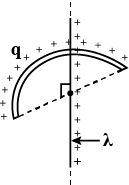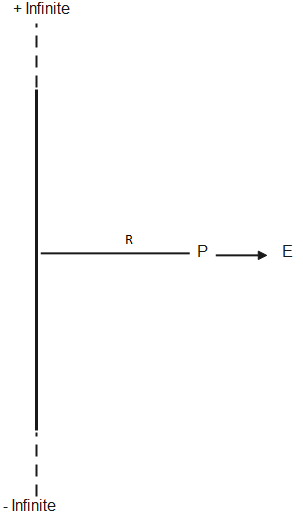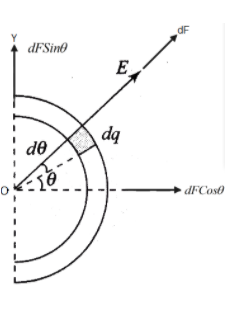
Find the force experienced by the semicircular rod having a charge q, as shown in figure. Radius of the wire is R and the line of charge with linear density λ passes through its centre and is perpendicular to the plane of wire.

a)\[\dfrac{\lambda q}{2{{\pi }^{2}}{{\varepsilon }_{o}}R}\]
b) \[\dfrac{\lambda q}{{{\pi }^{2}}{{\varepsilon }_{o}}R}\]
c) \[\dfrac{\lambda q}{4{{\pi }^{2}}{{\varepsilon }_{o}}R}\]
d)\[\dfrac{\lambda q}{8{{\pi }^{2}}{{\varepsilon }_{o}}R}\]

Answer
522.9k+ views
Hint: Here in this question we will use the concept of electric field due to infinite linear charge wire and concept of electric field calculation when point charge is not given then we will take a small portion and find the magnitude of charge on that portion then integrate that portion to get the complete calculation of electric field.
Complete step-by-step answer:
An infinite linear charge wire is given having linear charge density λ. We will first calculate the electric field due to this linear charge at Point P which is at perpendicular R from the charge wire. Electric field can be expressed as -
\[E=\dfrac{\lambda }{2\pi {{\varepsilon }_{0}}R}\] \[Equation1\] The direction of electric field is outwards because linear charge wire has positive charge density on it.

Now we will assume a semi circular ring of radius R having charge q distributed over it. We know that wire is passing through its centre O and perpendicular to its plane. Consider to reference axis X and Y.

Since there is no point charge so the direct formula of the electric field is not applicable, here q charge is distributed over a semicircular ring so we have to consider a small element having small charge dq and length of this small element is calculated as\[Rd\theta \]. This above value is calculated from the relation
\[Angle=\dfrac{Arc}{Radius}\]
\[\Rightarrow Arc=Angle\times Radius\]
\[\therefore Arc=Rd\theta \] The value of this dq is calculated by applying a unitary method.
Whole Semi Circular Ring of length πR carries charge =\[q\] 1 Unit length of that ring carry charge = \[\dfrac{q}{\pi R}\]
Rdθ length of a small element carries charge = \[\dfrac{q}{\pi R}\times Rd\theta \].
So value of \[dq=\dfrac{q}{\pi R}\times Rd\theta \]
\[\Rightarrow dq=\dfrac{qd\theta }{\pi }\].\[Equation2\]
Since wire is passed through the centre of semi circular rod and wire is having positive charge so electric field due to this wire is outwards as shown in the figure and semi circular rod is also having positive charge so direction of force is also outwards. Due to this electric field of wire force on small elements dq is also small and can be represented by dF.
So value of this force acting on small element will be \[dF=Edq\] Put the value of the electric field from equation 1.
So it becomes \[dF=\dfrac{\lambda }{2\pi {{\varepsilon }_{0}}R}dq\] \[Equation3\]
This force is now resolved in two components: - 1. \[dFCos\theta \](Along X axis)
2. \[dFSin\theta \](Along Y axis) Now if we consider same small element on other side of semicircular rod then same components are resolved and \[dFSin\theta \]is in opposite direction so it is cancel out and only effective component exist for this whole semicircular rod is \[dFCos\theta \].
So to calculate net force we have to integrate this \[dFCos\theta \]from 0 to π/2 on one side and then double it to get force due to the other side also. So net force will be \[{{F}_{net}}=2\int\limits_{0}^{\pi /2}{dFCos\theta }\]
Put the value of dF from equation 3 then we get \[\Rightarrow {{F}_{net}}=2\int\limits_{0}^{\pi /2}{\dfrac{\lambda }{2\pi {{\varepsilon }_{0}}R}dqCos\theta }\] Put the value of dq from equation 2, we get
\[\Rightarrow {{F}_{net}}=2\int\limits_{0}^{\pi /2}{\dfrac{\lambda }{2\pi {{\varepsilon }_{0}}R}\dfrac{qd\theta }{\pi }Cos\theta }\]
\[\Rightarrow {{F}_{net}}=\dfrac{q\lambda }{{{\pi }^{2}}{{\varepsilon }_{0}}R}\int\limits_{0}^{\pi /2}{Cos\theta d\theta }\] \[\Rightarrow {{F}_{net}}=\dfrac{q\lambda }{{{\pi }^{2}}{{\varepsilon }_{0}}R}{{[Sin\theta ]}^{\pi /2}}_{0}\] \[\Rightarrow {{F}_{net}}=\dfrac{q\lambda }{{{\pi }^{2}}{{\varepsilon }_{0}}R}[Sin\dfrac{\pi }{2}-Sin0]\] \[\Rightarrow {{F}_{net}}=\dfrac{q\lambda }{{{\pi }^{2}}{{\varepsilon }_{0}}R}[1-0]\]
\[\therefore {{F}_{net}}=\dfrac{q\lambda }{{{\pi }^{2}}{{\varepsilon }_{0}}R}\] Correct Option is B.
So, the correct answer is “Option B”.
Note: In such a type of question basic thing we have to remember about charge distribution. Whenever this continuous charge distribution is given then the principle of superposition is not applied, this principle is only applied when discrete charge distribution is given. Here in this question linear charge distribution is given so the principle of superposition cannot be applied.
Complete step-by-step answer:
An infinite linear charge wire is given having linear charge density λ. We will first calculate the electric field due to this linear charge at Point P which is at perpendicular R from the charge wire. Electric field can be expressed as -
\[E=\dfrac{\lambda }{2\pi {{\varepsilon }_{0}}R}\] \[Equation1\] The direction of electric field is outwards because linear charge wire has positive charge density on it.

Now we will assume a semi circular ring of radius R having charge q distributed over it. We know that wire is passing through its centre O and perpendicular to its plane. Consider to reference axis X and Y.

Since there is no point charge so the direct formula of the electric field is not applicable, here q charge is distributed over a semicircular ring so we have to consider a small element having small charge dq and length of this small element is calculated as\[Rd\theta \]. This above value is calculated from the relation
\[Angle=\dfrac{Arc}{Radius}\]
\[\Rightarrow Arc=Angle\times Radius\]
\[\therefore Arc=Rd\theta \] The value of this dq is calculated by applying a unitary method.
Whole Semi Circular Ring of length πR carries charge =\[q\] 1 Unit length of that ring carry charge = \[\dfrac{q}{\pi R}\]
Rdθ length of a small element carries charge = \[\dfrac{q}{\pi R}\times Rd\theta \].
So value of \[dq=\dfrac{q}{\pi R}\times Rd\theta \]
\[\Rightarrow dq=\dfrac{qd\theta }{\pi }\].\[Equation2\]
Since wire is passed through the centre of semi circular rod and wire is having positive charge so electric field due to this wire is outwards as shown in the figure and semi circular rod is also having positive charge so direction of force is also outwards. Due to this electric field of wire force on small elements dq is also small and can be represented by dF.
So value of this force acting on small element will be \[dF=Edq\] Put the value of the electric field from equation 1.
So it becomes \[dF=\dfrac{\lambda }{2\pi {{\varepsilon }_{0}}R}dq\] \[Equation3\]
This force is now resolved in two components: - 1. \[dFCos\theta \](Along X axis)
2. \[dFSin\theta \](Along Y axis) Now if we consider same small element on other side of semicircular rod then same components are resolved and \[dFSin\theta \]is in opposite direction so it is cancel out and only effective component exist for this whole semicircular rod is \[dFCos\theta \].
So to calculate net force we have to integrate this \[dFCos\theta \]from 0 to π/2 on one side and then double it to get force due to the other side also. So net force will be \[{{F}_{net}}=2\int\limits_{0}^{\pi /2}{dFCos\theta }\]
Put the value of dF from equation 3 then we get \[\Rightarrow {{F}_{net}}=2\int\limits_{0}^{\pi /2}{\dfrac{\lambda }{2\pi {{\varepsilon }_{0}}R}dqCos\theta }\] Put the value of dq from equation 2, we get
\[\Rightarrow {{F}_{net}}=2\int\limits_{0}^{\pi /2}{\dfrac{\lambda }{2\pi {{\varepsilon }_{0}}R}\dfrac{qd\theta }{\pi }Cos\theta }\]
\[\Rightarrow {{F}_{net}}=\dfrac{q\lambda }{{{\pi }^{2}}{{\varepsilon }_{0}}R}\int\limits_{0}^{\pi /2}{Cos\theta d\theta }\] \[\Rightarrow {{F}_{net}}=\dfrac{q\lambda }{{{\pi }^{2}}{{\varepsilon }_{0}}R}{{[Sin\theta ]}^{\pi /2}}_{0}\] \[\Rightarrow {{F}_{net}}=\dfrac{q\lambda }{{{\pi }^{2}}{{\varepsilon }_{0}}R}[Sin\dfrac{\pi }{2}-Sin0]\] \[\Rightarrow {{F}_{net}}=\dfrac{q\lambda }{{{\pi }^{2}}{{\varepsilon }_{0}}R}[1-0]\]
\[\therefore {{F}_{net}}=\dfrac{q\lambda }{{{\pi }^{2}}{{\varepsilon }_{0}}R}\] Correct Option is B.
So, the correct answer is “Option B”.
Note: In such a type of question basic thing we have to remember about charge distribution. Whenever this continuous charge distribution is given then the principle of superposition is not applied, this principle is only applied when discrete charge distribution is given. Here in this question linear charge distribution is given so the principle of superposition cannot be applied.
Recently Updated Pages
Master Class 12 English: Engaging Questions & Answers for Success

Master Class 12 Economics: Engaging Questions & Answers for Success

Master Class 12 Social Science: Engaging Questions & Answers for Success

Master Class 12 Maths: Engaging Questions & Answers for Success

Master Class 12 Chemistry: Engaging Questions & Answers for Success

Master Class 12 Business Studies: Engaging Questions & Answers for Success

Trending doubts
What are the major means of transport Explain each class 12 social science CBSE

Which are the Top 10 Largest Countries of the World?

Draw a labelled sketch of the human eye class 12 physics CBSE

Explain sex determination in humans with line diag class 12 biology CBSE

The pH of the pancreatic juice is A 64 B 86 C 120 D class 12 biology CBSE

Explain sex determination in humans with the help of class 12 biology CBSE




